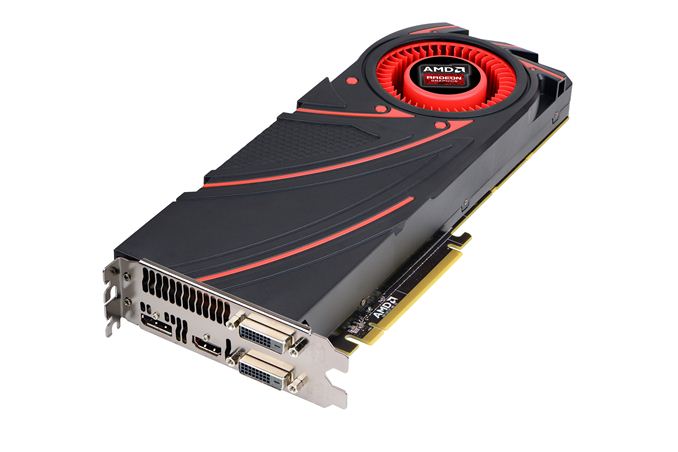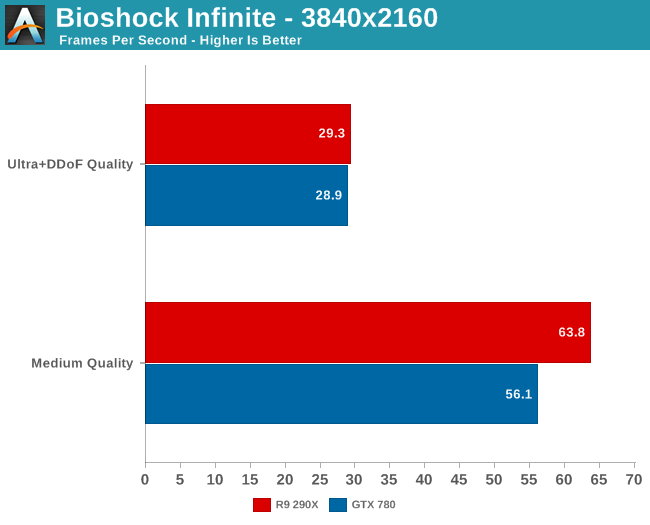AMD Radeon R9 290X Performance Preview: Bioshock Infinite
by Ryan Smith on October 17, 2013 3:00 PM EST- Posted in
- GPUs
- AMD
- Radeon
- Hawaii
- Radeon 200

As something of a counter-event to NVIDIA’s gaming showcase taking place in Montreal, Canada this week, AMD has organized an early, brief reveal of their forthcoming Radeon R9 290X video card. The card won’t be launching until sometime in the future, but for today we’re being allowed to confirm that we have the card and are being allowed to publish a single benchmark: Bioshock Infinite at 3840x2160 (4K).
AMD has purposely kept the public details on the R9 290X sparse so far, so we know little other than that it’s a larger GPU rated for 5 TFLOPS of compute performance, and paired with 4GB of memory for a total memory bandwidth of over 300GB/sec. Like most segments of the consumer electronics industry AMD has been gearing up for 3840x2160 (4K) displays, so the Radeon 290X is AMD’s flagship card geared towards gamers using 3840x2160 or 2560x1440 monitors.
Consequently AMD is seeking to draw attention to their 4K performance with today’s benchmark reveal. AMD named the game, the cards, and the resolution – Bioshock at 4K against the GTX 780 – so this is a very limited subset of our full results. And as with all controlled benchmark releases we’d advise not reading too much into any single benchmark here, as the relative performance of NVIDIA and AMD cards changes with the game being tested, at times rather wildly..

The biggest problem with 4K displays for at least the intermediate future, other than price of course, will be that you’re either going to need a lot of GPU power to drive them or will have to take a quality hit to achieve acceptable performance. Neither the R9 290X nor the GTX 780 are powerful enough to stay above 30fps on Bioshock with everything turned up. For that you will need to drop down to Medium quality, which gets performance past 30fps and up into the 60fps range. The fact that we’re even talking about playing a game at 60fps this high of a resolution – with 2.25 times as many pixels as 2560x1440 – is a big accomplishment right there, it’s just not one that will come without tradeoffs. For little-to-no compromise 4K gaming we’ll undoubtedly need to turn to multiple GPUs and Crossfire/SLI.
Moving on, it’s interesting to note in this case that both cards are essentially tied at Ultra quality, but when we dial down to medium the 290X takes a very decisive 14% lead. At the highest quality settings we should be shader/texture bound due to the significant use of shader effects on Bioshock’s highest quality settings, whereas at lower quality settings at least some of the bottleneck will shift to elements such as ROP throughput, memory bandwidth, and the geometry pipeline.
Wrapping this preview up, we’ll have more details on the 290X in the near future. AMD has made it clear that they are aiming high with their new flagship video card, so it will be interesting to see what they can pull off as we approach Tahiti/7970’s second birthday.













89 Comments
View All Comments
brucek2 - Friday, October 18, 2013 - link
Way to miss the big picture. The combined market share of the R290, and the 780 and/or Titan, is a rounding error away from zero. The competitive differences between them will affect at most a tiny slice of the PC user base, and any competitive rankings today will be obsolete within 6 months if not 3. All of that is small beans.The larger issue, which will endure for much longer, and will apply to much more mainstream products affecting much greater numbers of users, is the rules of engagement between the tech press and the manufacturer. No one has yet responded to my original question, which was to name another example where the tech press accepted such one sided rules. I believe AMD's PR operation broke new ground today. They got away with it first, but now that precedent has been set they surely won't be the last. Nvidia will of course respond in kind, but the bigger picture is so will other manufacturers in other product categories.
Tech press is relatively new because tech itself is relatively new. Broader journalism has been around a lot longer, has covered issues that have much more far reaching implications, and has arrived at rules that make sense in protecting the freedom of the press and therefore its readers. Not accepting undue editorial control in exchange for materials, access, favors, etc is an important part of that. The tech press blew it today and we will all eventually be worse off for their mistake.
WritersBlock - Monday, October 21, 2013 - link
I have to say, that bruck2 makes a good point. But in fairness to anandtech, their disclaimer was hard to miss.takeship - Friday, October 18, 2013 - link
We don't know just quite yet whether or not these numbers have been fudged, but we will in a few more days time. No doubt EVERY site will now run a Bioshock Infinite bench at this res to double-check AMDs claim, and yell to the heavens if AMD was dumb enough to fudge something so easily verifiable. I would like a comment of some sort as to why the 290X score is listed as "Quiet Mode." That parts seems to be marketing driven to me. (i.e. low PowerTune matches a 780, balanced matches a Titan, performance takes them out back)TheJian - Thursday, October 17, 2013 - link
http://www.tomshardware.com/news/amd-radeon-r9-290...Toms was told which games and how to run them...This type of crap would be pounced on here by Ryan if NV did this. Note they are completely ignoring NV's show in montreal...ROFL. Still don't see an NV portal page either to complement the AMD portal they have here. How much does AMD pay anandtech these days?
nsiboro - Friday, October 18, 2013 - link
@brucek2, @HisDivineOder:TL;DR;
You guys going hypotheticals and fantasizing "What-Ifs" = trying so very hard to make something out of nothing.
It's a preview result. The end.
brucek2 - Friday, October 18, 2013 - link
@nsiboro - the admission that AMD "named the game, the cards, and the resolution" is in the 3rd paragraph. The fact that AnandTech accepted those conditions and ran the story anyway is evident by the existence of this article. There is nothing hypothetical or what iffed about it.nsiboro - Friday, October 18, 2013 - link
@brucek2Lots of Q?, "Maybe", "Assume", "Say...", "Titanic" (so sad, it sunk), "Imagine", "Implies", etc.
*These words. *sigh*
*According to you, the publishing of this 1 preview = doomed all journalistic integrity at this site and all over the Internet.
"The combined market share of the R290, "
*R9-290/X is not out yet, authority sources?*
"All of that is small beans."
*I dunno, 780/Titan are priced very high*
So, you are not OK with this site and many other (as they also published the same preview).
I can respect that.
brucek2 - Friday, October 18, 2013 - link
I could answer those nits but I don't want to distract from my main contention, still unanswered. I believe that AMD broke new ground by placing such tight conditions on what could be discussed in the preview, and the press accepting it.To all those claiming this is not a big deal and simply business as usual, my question stands -- point me to any previous AnandTech (or other similarly respectable site) article that allowed the manufacturer to dictate the content to that extent. I'm aware that sometimes there's just very little data to report period, so see that as a different case; but here, the team had the ability to generate as many data points as desired yet accepted the restriction to use only those of the manufacturer's choosing.
You may call it a hypothetical, but allowing control over the one and only game allowed in the story is not so very far from allowing say only positive vs negative comments in a story. The latter demand would have hopefully been laughed out of the room; but I am not understanding why the former should not also have been.
nathanddrews - Friday, October 18, 2013 - link
If AMD invited me to their party and told me that I could run benchmarks for just one game on their brand new super double top secret GPU and share those results with the world, I would do exactly that. I would also include the disclaimer that AT did. I don't see the problem. It's labeled as a preview. No different than press events hosted by Intel or NVIDIA, Samsung or Apple.Put down the Haterade.
brucek2 - Friday, October 18, 2013 - link
The difference is not having more information vs. accepting restrictions on information you do have.Every reporter faces the challenge of receiving biased, partial information from one sided sources (i.e., a press conference.) Choosing how to evaluate and present that information, and how to complement it with information from other sources, and whether it is ready to run at all, are all basic tasks of journalism.
That's not what's happening here though. This and other blogs have more information, but they agreed to terms that they would first report only the specific portion of the information that the manufacturer requested. The response with journalistic integrity would have been to decline those terms.